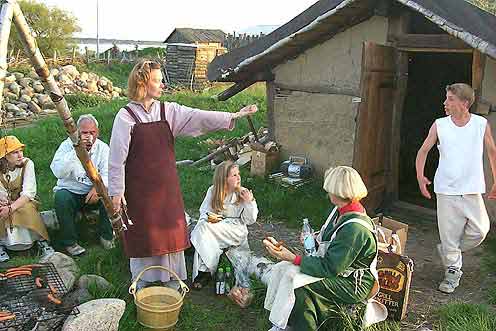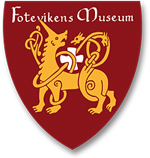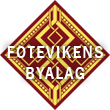Information for teachers

The Viking Town is a place presenting a lot of history that can be used for teaching in a number of ways. Try to utilise the time spent in the Viking Town to do a bit more than the Viking-led activities during your visit.
Preparing the class of the history in the area around Foteviken Museum. Before Harald Bluetooth introduced Christianity a so called "Vi", a holy sacrifical grove, or perhaps even a pagan temple, was located near the town. This was likely torn down on Harald's orders. Instead a wooden church was constructed next to the current day Viking Town. The kings demesne was located nearby as well. The winter harbor of the Scanian warfleet was located within the bay of Foteviken.
On the museum home page we will publish many texts and articled about Scanian history and the history around Foteviken. You may use this material to prepare the class ahead of the visit. Let the class work with different questions regarding the Viking Age and Foteviken, like:
- Which pagan gods were likely worshipped at Foteviken, and how did the pagan cult work?
- How could King Harald introduce a new religion? Would not the people protest?
- How did a wooden christan church look?
- What is a ledung fleet and how were warriors assembled for the ships?
- How did viking ships look?
- Where was the wood and materials for the ships obtained, and where did the iron come from to assemble the many wooden planks into a ship?
- Who was really King Harald Bluetooth?
- While you are at it, tell a bit about his son Sweyn Forkbeard?
- How would the viking age royal demesne have looked?
A tip for you as a teacher is to browse Wikipedia. Here we from Foteviken along with other Viking Age experts have assembled facts and material that may be useful to know. A few example pages:
During your visit in the Viking Town we wish for you as teachers to help out and act as Viking assistants during the various activities. It is also useful if you have asked the pupils to be obvservant of the various small details within the Viking Town. How are the walls made, what tools may have been used during construction of buildings, how are the buildings decorated, what objects are found inside, how do various things work? Pupils should be history detectives to understand that you must be curious and ask and seek answers by asking, talking and thinking.
Rules for the visit
The Foteviken Viking Museum has a set of rules for visitors that need to be followed to ensure visit will be nicer and more productive for everyone: These are:
- The teacher is responsible for the conduct of the class during the stay and should be present to assist the museum staff if necessary. Our Viking educator in responsible for the teaching.
- Do not wander the reconstructed Viking town without the Viking educator before or after the school activity.
- Do not leave any valuables in your bags left in the bag depository - we are not responsible for the protection of your valuables.
- Accompanying adults/teachers are expected to actively participate and accompany the pupils during the activity.
- The children are not allowed to climb onto the roof of the buildings or onto the town wall.
- If there are domesticated animals in the town they are to be left alone and not harassed.
- Any brought food may not be eaten within the museum area. There are benches and picnic tables outside the museum entrance by the scenic vantage point facing the sea. These are intended for school class use.
Responsibility of adults
Sadly there has been incidents with damage done to the museum facility during school visits in the past. Thus we feel the need to point out that the accompanying adults are responsible for the behavior and actions of individual pupils within our historic environments. If any pupil cause damage or steal things from the museum the school will be liable to pay for damages. If the rules are not followed the museum reserves the right to cancel the visit of the whole class with full charge.
















